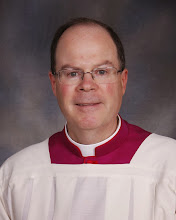Friday, March 30, 2018
We WERE There When They Crucified the Lord (Good Friday)
Were you there when they crucified my Lord?
That haunting question comes from an American spiritual that was likely composed in the nineteenth century by African-American slaves, people who knew a great deal about sorrow and suffering.
The power of the hymn is seen in an interesting fact: it was a favourite of the great Hindu leader Mahatma Gandhi.
The hymn helps us to stand at the foot of the cross with Mary and Mary Magdalene and St. John, and to enter into Christ's passion not only with our heads but our hearts as well.
The words "were you there when they crucified my Lord?" are so moving that I once gave an entire homily on them. But today I would like to change them from a question to a statement: you were there when they crucified the Lord.
Every man, woman and child in church this afternoon was there on Calvary--not standing at the foot of the cross, but hanging on the cross with Christ. We were there when they crucified the Lord.
That may sound surprising. But it comes straight from St. Paul. If you are lucky enough to be with us for the Easter Vigil tomorrow, you will hear him say plainly in the Letter to the Romans that "we have died with Christ."
The Apostle tells us that "our old self was crucified with him." Can we hear those words and doubt that we were there, that our humanity hung on the cross in Christ?
The Letter to the Hebrews explains how this is possible. In the second chapter, it says Jesus "had to become like his brothers and sisters in every respect, so that he might be a merciful and faithful high priest... to make a sacrifice of atonement for the sins of the people."
In today's liturgy the Letter to the Hebrews anticipates an objection. We think that Jesus, the great high priest, must be unlike us in order to offer himself on our behalf. It anticipates the reaction of the Jewish people, who read in the Old Testament that the priest had to be set apart so he could relate to God.
These reactions are understandable, today's reading from Hebrews says, but they are wrong. Our priest, though he is the Son of God, is human in every way that we are, though without sin. He shared our flesh and blood, our human nature, to make us truly his brothers and sisters.
And so, we were there. There in our weakness, there in our sinfulness, there in our human flesh. Jesus took it all to the cross.
If I have convinced you, if Scripture has convinced you, there's still a final question. What difference does it make that we were there, there in our old self that was crucified with him?
First, let me answer with exquisite words from St. Melito of Sardis, an Asian bishop of the second century.
"For the sake of suffering humanity [Christ] came down from heaven to earth, clothed himself in that humanity in the Virgin’s womb, and was born a man. Having then a body capable of suffering, he took the pain of fallen man upon himself; he triumphed over the diseases of soul and body that were its cause, and by his Spirit, which was incapable of dying, he dealt man’s destroyer, death, a fatal blow," the saintly bishop wrote.
What joy, then, for us to be sharers in the cross of Christ--because it means we share also in his victory over sin and death, over fear and hopelessness.
At the Easter Vigil St. Paul has the last word on this. But I will give you a preview. He writes that our old self was crucified with Christ for a reason: "so that our sinful body might be done away with" [NAB]. He died that we might be free, that "we might no longer be enslaved to sin. For whoever has died is freed from sin" [NRSV].
We were there when they crucified our Lord. We were there when they laid him in the tomb. And we are there in his glorious resurrection, believing that if we have died with Christ we will also live with him, dead to sin and alive to God.
Subscribe to:
Post Comments (Atom)


No comments:
Post a Comment